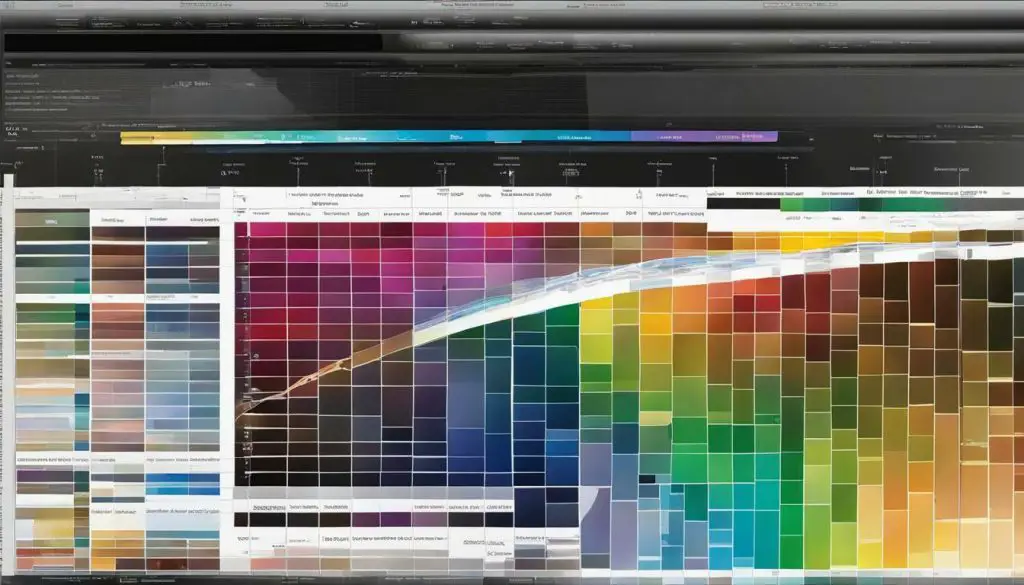
When it comes to creating visually stunning and impactful images, understanding the color capabilities of the JPEG format is crucial. JPEG is one of the most popular image formats used today, with support for a vast range of colors. If you’re wondering how many colors JPEG supports or are looking to optimize your JPEG images for various applications, read on for a detailed guide.
Key Takeaways:
- JPEG supports a vast range of colors.
- Understanding how many colors JPEG supports is crucial for optimizing image quality.
- Optimizing JPEG images involves using appropriate compression settings and reducing unnecessary color information.
Color Depth in JPEG: Explained
Color depth refers to the number of colors that can be represented in an image. In the case of JPEG, the standard color depth is 24 bits per pixel (bpp), which translates to over 16 million different colors. This vast range of colors ensures that JPEG images can display highly detailed and vibrant visuals, making them an ideal choice for various applications.
When it comes to colors supported by JPEG, the 24 bpp standard color depth allows for a broad range of hues and shades. This color depth comprises eight bits each for red, green, and blue color channels. By combining these colors in various amounts and intensities, a vast array of distinct colors can be represented in a JPEG image.
However, it’s important to note that not all JPEG images use the full range of available colors. The actual number of colors used in a JPEG image depends on various factors, including the original image’s color depth, compression settings, and the number of distinct colors present in the image itself.
When optimizing JPEG images, it’s crucial to ensure that the colors are accurately represented. Poorly optimized images can result in color-band artifacts, where colors appear in distinct bands rather than smoothly blending into each other.
By understanding color depth in JPEG and optimizing your images appropriately, you can make the most of the color support provided by the format and create visually stunning images for various applications.
The Maximum Number of Colors in JPEG
Although JPEG supports over 16 million colors, not all images will utilize the full range. The actual number of colors used in a JPEG image depends on various factors, including the original image’s color depth, compression settings, and the number of distinct colors present in the image itself.
For example, an image with only a few colors, such as a logo, may only use a fraction of the 16 million colors available. On the other hand, a photograph of a sunset may use many more colors within the image.
To determine the maximum number of colors in a JPEG image, you can use image editing software to view the image’s color information. This will display the number of distinct colors used in the image and can help you optimize the image’s color depth for your intended use.
Keep in mind that while a high number of colors can result in a more visually stunning image, it can also increase the file size, which may impact the image’s loading time on websites or in other applications. Therefore, it’s crucial to balance image quality with file size when optimizing JPEG images.
Optimizing Colors in JPEG
Optimizing images is essential for ensuring that they look their best while keeping file sizes manageable. When it comes to JPEG images, color optimization is particularly crucial. Here are some tips for optimizing colors in JPEG:
Use appropriate compression settings: Compression settings determine the degree of data reduction in an image, which can affect color accuracy and image quality. It’s essential to strike a balance between file size and image quality, as excessive compression can result in significant color loss and pixelation.
Ensure colors are accurately represented: If your image features a specific color scheme or includes items with distinct colors, it’s crucial to ensure that those colors are represented accurately. This may involve adjusting the image’s color balance or using software tools to fine-tune colors further.
Reduce unnecessary color information: JPEG images can contain a vast number of colors, but not all of them may be essential to the image’s overall look and feel. By removing unnecessary color information, you can reduce file size while maintaining image quality.
Consider the image’s end-use: The optimal color settings for a JPEG image may vary depending on how and where the image will be used. For example, an image intended for web use may require different color optimization settings than an image intended for print.
By following these tips and optimizing your JPEG images, you can maximize their visual appeal and ensure that they look their best in a variety of different applications.
Conclusion
As we have learned, JPEG offers vast color support with a standard color depth of 24 bpp, providing over 16 million different colors. However, it is essential to consider various factors like compression settings, original image color depth, and the number of distinct colors present in an image to optimize the color usage.
By understanding the color capabilities of JPEG and optimizing the images accordingly, you can create visually stunning and impactful images suitable for a wide range of applications. Whether you are designing web graphics, printing photos, or creating digital art, maximizing the color support in JPEG format is crucial.
